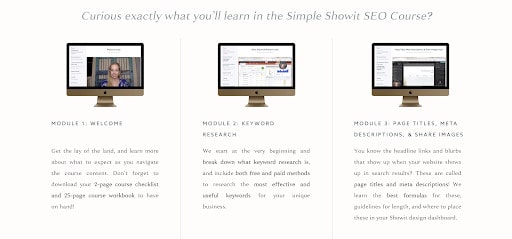Business, Creative Entrepreneurs, Interior Designers, Photographers, Tips & Tricks, Wedding Professionals
I don’t know about you, but I’ve loved the process of building my business team.
It feels a little risky when you make your first hire, but that’s only because you have to get comfortable with loosening the reins of control. Trust me, it gets easier over time.
As entrepreneurs, it’s common for us to feel weighed down by all of the hats we have to wear. One minute you’re jumping on sales calls to sell your offers and the next you’re replying to emails while trying to complete your to-do list for the day.
When that weight becomes too heavy to carry alone, it’s time to think about outsourcing tasks that are currently on your plate. It feels less scary when you understand who you need to hire and confidently know which task they’ll be responsible for.
Hiring experts in different fields allows me to hyper-focus on my own role as a Showit website designer and strategist for my clients. I’m not in business to be the best at managing my Instagram or Pinterest accounts, but those tasks could fill my whole calendar if I’m not careful.
By outsourcing some of your work to other freelancers or service providers, you’ll be able to spend more of your time on projects you love. Isn’t that the goal of running your own business, after all?
If you aren’t sure where to start with outsourcing, I want to give you a few prompts that may help you make a well-informed decision. All of them are open-ended questions, so you can jot down your answers in a journal or consider each of them in your mind. Let’s start with the first one.
Does the task fit your skillset?
As a business owner, you bring a unique set of skills to the table. If you haven’t already, I recommend creating a list of your core strengths so you have a clear picture of what work you do best.
The hope is to create a role inside your business that allows you to effectively utilize all of your strengths while outsourcing areas of weakness. If you’re not sure what they are, you may want to take personality tests like the Enneagram or Myers Briggs, although the most helpful might be the StrengthsFinder assessment.
When you’re thinking about outsourcing a task, it’s good to assess if you enjoy it and if it fits within your strengths. If it aligns with your expertise or is something you’re known for, you may want to keep it in your list of responsibilities.
While I could hire a team of website designers to help me take on more projects, I really like working 1:1 with my clients and walking them through my signature process. For this reason, I don’t outsource much of client work to other contractors because I want to be hands-on with each project.
However, if there’s a task that doesn’t fit into your current skillset, this could indicate that it will take more time and effort from you in order to complete the task than other entrepreneurs. Since you want to spend your time on income-producing projects, it might be best to outsource in this instance.
Do you have interest in learning this skill?
There are many things you have to learn at the beginning of your business, like how to make quarterly estimated tax payments, follow a sales strategy, or create a business plan. As you learn what it takes to run a healthy, sustainable business, you might feel motivated to pass off some of your tasks to someone else. It’s only natural to do so as your business grows.
In my own business, there are plenty of tasks I could do, but I either don’t want to do them or would rather have someone else take care of them for me. There’s no shame in that!
The people I hire are usually more efficient than I am with completing the specific task because they’re leaning into their own strengths. They bring valuable perspectives and creative ideas I never would have come up with on my own. That’s the beauty of working with a team.
A great example of this is when I hired Josie Derrick to take my brand photos. I could have set up a tripod and tried to take photos myself, but they wouldn’t have been even close to as professional as the photos from Josie. I’d hire her again in a heartbeat!

Hiring a photographer for a brand photoshoot may seem like an obvious example, but the same can be said for hiring Paige of Griffith Law, PLLC. I consult with her whenever I run into anything that needs legal expertise. I have no desire in learning the ins and outs of business law, so hiring Paige is always a no-brainer.
As you consider what skills are outside of your wheelhouse, let’s move on to the next question.
How many hours would it take you vs. an expert?
This question is crucial to answer when you’re thinking about outsourcing an area of your business. Even if you could technically get the task completed, how long would it take you versus someone else who does this all the time?
Also, does it feel like someone else could do it in far less time than you could? If your answer is yes, it might be time to hire an expert instead. Since you want to focus on tasks that are in your expertise—meaning you’re more efficient at completing them—you don’t need to have as much control over this specific area.
To give you an example, I hired Kayla Hollatz a few years ago to ghostwrite content for my website and blog. I started my blog before that, but when my plate became too full to continue prioritizing it, I hired Kayla for extra help.

Again, I could write all of my content on my own, but it made sense to hire a professional and outsource this task. I cannot stress enough how many hours it saves me! While it only takes Kayla about three hours to outline, research, and write a blog post, it would probably take me a day or two. All of our blog posts are optimized for website search too, so I know I’m getting the most out of our work together.
Now, I can spend those days creating beautiful, streamlined websites for my creative entrepreneur clients. Like many of my team members, I’ve found it’s an investment worth making, and I have a feeling you’ll feel the same way when you start outsourcing.
Do you want to work less hours?
Since we’re talking about your time, you might want to take a moment and think about how many hours you want to work.
As business owners, it’s all too easy for us to burn the midnight oil and work as many hours as it takes to get the job done. This may work for a season, but you can’t sustainably run a business with your “hustle mode” turned on every day.
If you’ve never done this practice before, I recommend starting by tracking the amount of hours you currently work. You can do this through Toggl or any similar tool. Once you’ve tracked your time, you can see where you want to cut down on hours based on the work you’re completing right now.
I remember what it was like to work 50-60+ hours each week on my business in the early days. It helped me get to where I am, but it’s not a long-term rhythm I would recommend to anyone. Instead, I’ve learned to work during my most productive hours and prioritize other things in my life with the way I set up my schedule.
I’m also really inspired by other entrepreneurs who are thoughtfully reducing their hours to make time for what really matters. Shay Cochrane, the founder of the Social Squares stock photo membership site, only works around 16 hours a week and has done so for nearly 10 years. Can you believe it?
There are so many other examples of entrepreneurs who are choosing to hire a team so they can build their dream life. I’d count myself as a part of this group now, and the journey has been so rewarding.
How much profit would I make if I started outsourcing?
Now that you know how many hours you ideally want to work and how many hours an expert could save you, one of the last pieces of the puzzle is to determine how much you’d profit from outsourcing.
To do that, you have to think about how much your time is worth as compared to what you’d be paying a contractor to help you. I want to respect the collaborators I work with by keeping our actual payments private, but I’d love to illustrate how this works with a fictional example.
Let’s say I decided to hire someone who can help me edit course video materials for additional lessons I’m adding to Simple Showit SEO, my signature course. Again, I could try to edit these videos on my own, but it would take a great deal of time and energy from me. Since I have a fully booked calendar of client projects, it’s easy for me to make the decision to outsource it.

If I were to say my rate was $100/hour in this scenario, and the video editor only charges me $30/hour, I would save around $70 for each hour I work on client work instead of on this project. I also get to write-off the expense for additional tax savings, so this turns out to be a no brainer!
You can replace these numbers with your own. If you sell value-based packages rather than hours, try to estimate how many hours it usually takes you to complete everything in the package and use that as your guide. This exercise can be astounding!
Are you connected with someone who would be a great fit for the task?
With your answer to the last question, you may feel more energized and confident in outsourcing than ever! Let’s keep that momentum by jumping into this next question. As we’ve talked about the tasks you want to outsource, has anyone in your network come to mind as a potential good fit?
Depending on the size of your community, you may know of someone right now who you’d love to have on your team. This is the ideal scenario, but if you’re not sure who to hire, there are two different routes I recommend taking.
One is to do your research. Search on Google, YouTube, Instagram, or Facebook to find experts who have experience in working in your industry. When you visit their website, they may list their prices and packages on it so you know what to expect. If you’re interested in exploring the partnership, you can email them and set up a time to talk about your project.
The other is to ask for referrals from other business owners you trust. This is one of my favorite strategies to use when outsourcing because who better to connect with than someone who is already vetted?
Most of the people on my team have been recommended or referred in some way. Either that, or we’ve built a relationship ahead of time so I knew who they were before we began working together. You’ll want to consider this strategy when we cover the last question…
Do I need their help on an ongoing basis?
Once you choose potential partners you might want to hire, you’ll need to decide whether you need them for a one-time project or an ongoing basis. Not every team hire has to be hired on a weekly or monthly basis, but some of them might be.
Here are examples of service providers you might hire for a one-time project:
- Website designer (like me!)
- Website developer
- Sales copywriter
- Brand photographer
- Course launch professionals
- Social media ad experts
- Business consultant (with an hourly rate)
- Business strategist of any kind
You might want to hire someone on an ongoing basis if they are a:
- Virtual assistant
- Social media manager
- Editor or proofreader
- Graphic designer
- Blog ghostwriter
- Content creator
- Business coach
Even if I hire someone for a one-time project, like brand photographer Josie Derrick, I still treat them the same and consider them a part of my team like I do for ongoing members like my Pinterest manager from Wildroot Marketing. You can do the same whenever you outsource tasks.
Now you have everything you need to thoughtfully approach outsourcing in your business. With these questions, you’ll be able to determine when it’s time to outsource and who you need to hire next. It’s probably smart to bookmark this resource so you can come back to it anytime you need to hire someone new. Just saying… 🙂


